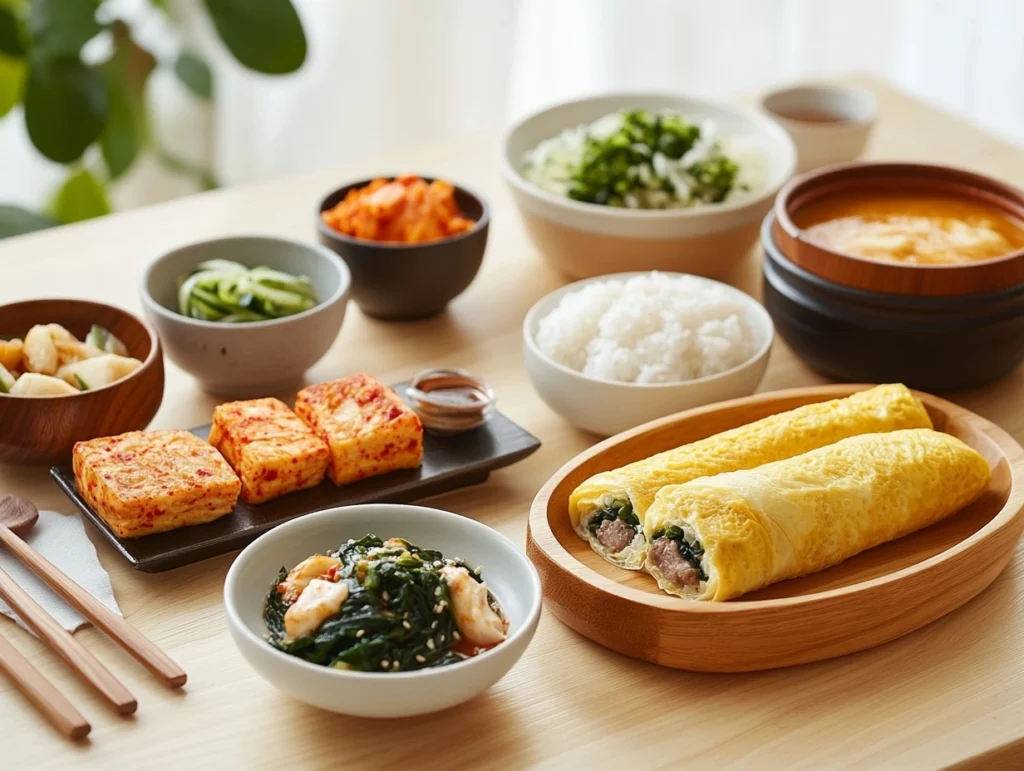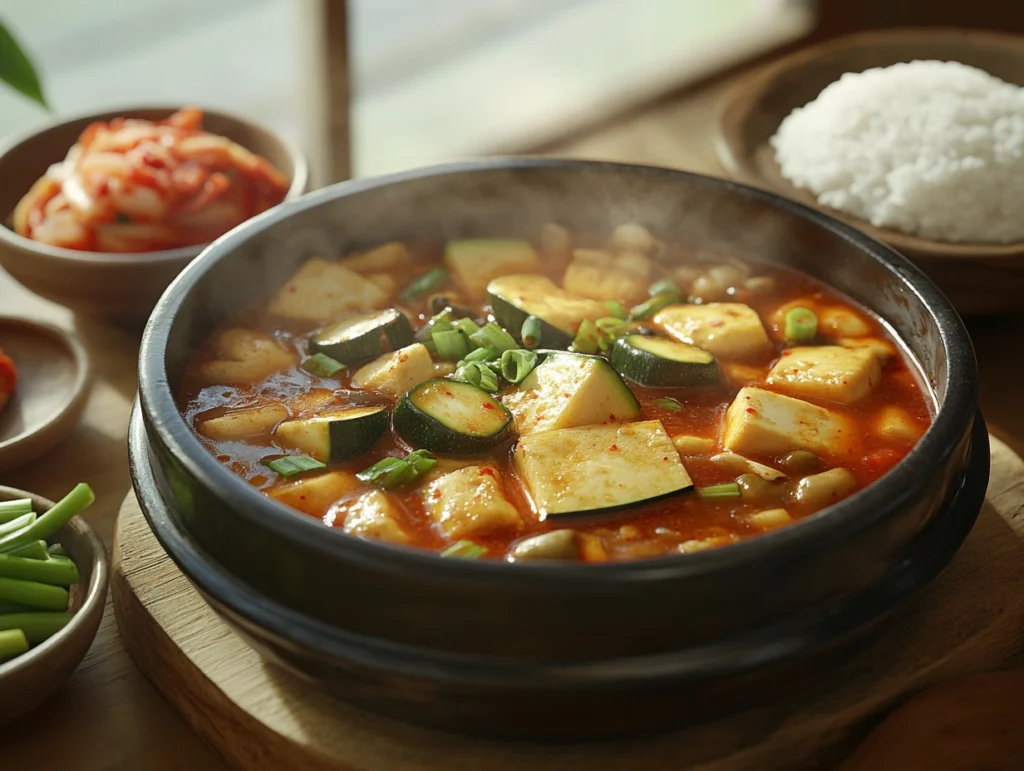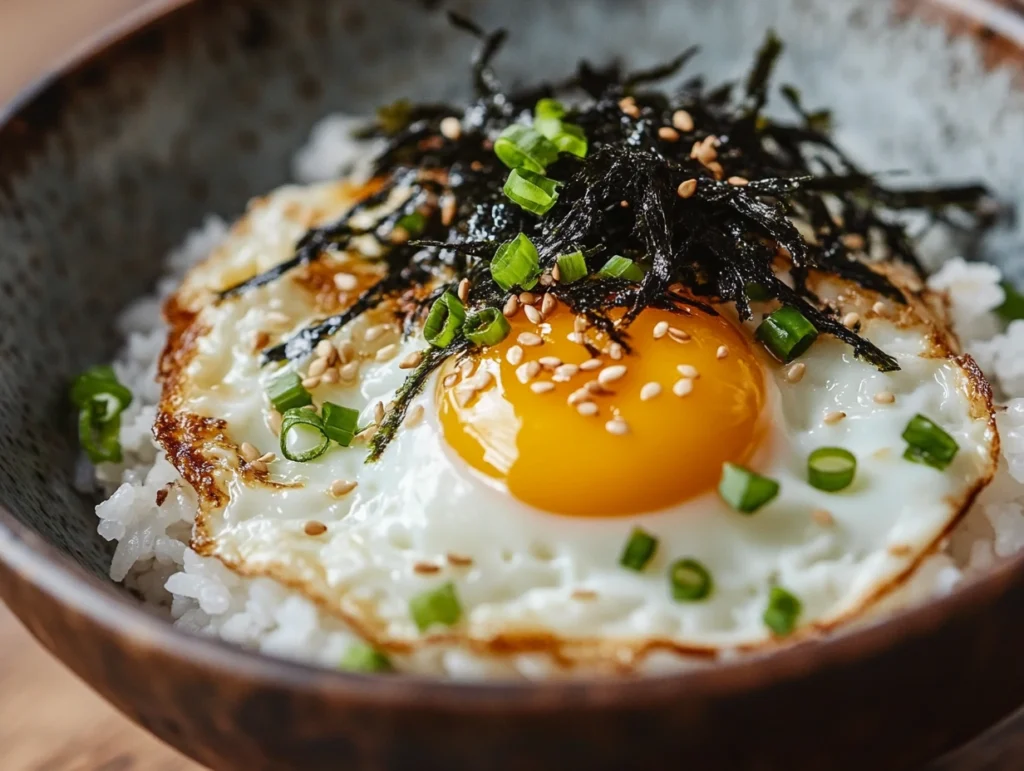1. Introduction
Breakfast holds a special place in Korean culture, reflecting its values of balance, variety, and health. Unlike typical Western breakfasts, which may focus on quick and sweet options like cereals or pastries, Korean breakfasts emphasize savory dishes, nutrient-dense ingredients, and a sense of harmony in flavors and textures. From rice and soups to kimchi and side dishes, every component works together to create a wholesome meal.

Alt Text: A traditional Korean breakfast spread with rice, soup, and side dishes.
In Korean homes, breakfast isn’t just a hurried affair. It’s a time to enjoy a complete meal that energizes the body for the day ahead. Even busy mornings often feature quick adaptations of traditional staples. Whether you’re exploring Korean cuisine for the first time or looking to expand your breakfast repertoire, this guide will introduce you to the flavors, techniques, and traditions of Korean morning meals.
2. Traditional Korean Breakfast Components
Korean breakfasts are known for their diversity and nutritional balance. Here are the key components that form the foundation of this traditional meal:
2.1. Steamed Rice (Bap)
Rice, or bap, is the heart of almost every Korean meal, including breakfast. It’s a simple yet versatile staple that pairs well with a variety of dishes. While white rice is the most common choice, other variations like brown rice or mixed grains (Japgokbap) are also popular for their enhanced nutritional benefits.
Steamed rice acts as the perfect canvas for savory side dishes and hearty stews. Preparing rice in a modern rice cooker ensures perfect texture every time, making it easy for even beginners to achieve the authentic Korean dining experience.
2.2. Soups and Stews
Soups and stews are essential to a traditional Korean breakfast, offering warmth, comfort, and nutrition. These dishes are usually light yet packed with flavor, making them the perfect way to start the day.

Alt Text: Doenjang Jjigae, a Korean soybean paste stew with vegetables and tofu.
2.2.1. Doenjang Jjigae (Soybean Paste Stew)
Doenjang Jjigae is a hearty and nutritious stew made from doenjang (fermented soybean paste), tofu, and vegetables such as zucchini, mushrooms, and onions. Often served alongside steamed rice, this stew delivers a rich, umami flavor that satisfies the palate.
Preparation is simple: dissolve a spoonful of doenjang in water or broth, add vegetables and protein like tofu or beef, and let it simmer until the flavors meld together. The probiotics in doenjang promote gut health, while the high protein content from tofu makes this a filling choice for breakfast.
2.2.2. Miyeok Guk (Seaweed Soup)
Known as birthday soup in Korea, Miyeok Guk is made from dried seaweed, sesame oil, and a protein source like beef or mussels. It has a delicate, briny flavor and is highly nutritious, offering a good source of iodine, calcium, and omega-3 fatty acids.
Miyeok Guk is often consumed postpartum due to its iron-rich content, but it’s also a popular breakfast option thanks to its simplicity and health benefits. To make it, rehydrate dried seaweed, sauté it with sesame oil, then simmer in broth with your protein of choice.
2.3. Side Dishes (Banchan)
No Korean meal is complete without banchan, an array of small side dishes that provide bursts of flavor and variety. For breakfast, lighter banchan options are typically served, adding texture and taste to the meal.
Popular Breakfast Banchan:
- Stir-fried Anchovies (Myulchi Bokkeum): Small, crispy anchovies sautéed with soy sauce, garlic, and sesame seeds. This dish is packed with calcium and protein.
- Seasoned Spinach (Sigeumchi Namul): Blanched spinach mixed with sesame oil, garlic, and soy sauce, offering a fresh, nutty flavor.
- Rolled Omelets (Gyeran Mari): Thinly rolled layers of egg, often filled with chopped vegetables or seaweed. These are rich in protein and visually appealing.
These small dishes can be prepared in advance, making them convenient for busy mornings. Pair them with steamed rice and soup for a traditional breakfast spread.
2.4. Fermented Foods
Fermented foods are a cornerstone of Korean cuisine, and breakfast is no exception. These dishes not only add bold flavors to the meal but also provide numerous health benefits, including improved digestion and enhanced gut health.
2.4.1. Kimchi
Kimchi, Korea’s most iconic dish, is a staple on the breakfast table. Made from fermented vegetables like napa cabbage or radish, kimchi is seasoned with garlic, ginger, chili flakes, and fish sauce. Its tangy, spicy flavor balances the richness of soups and rice, making it a perfect complement to any Korean breakfast.
Kimchi is rich in probiotics and vitamins, supporting a healthy immune system. With countless regional varieties available, from mild white kimchi (Baek Kimchi) to fiery red kimchi, there’s a type to suit every palate.
2.4.2. Other Fermented Staples
In addition to kimchi, other fermented foods enhance Korean breakfasts:
- Jeotgal (Fermented Seafood): Salty and umami-packed, jeotgal is often made from shrimp, squid, or clams. A small serving adds a burst of flavor to rice or soups.
- Gochujang (Fermented Chili Paste): Commonly used as a seasoning, gochujang adds a sweet-spicy depth to dishes like bibimbap or as a side condiment.
3. Popular Korean Breakfast Dishes
3.1. Gyeran Bap (Egg Rice)
Gyeran Bap, or egg rice, is a simple yet comforting dish made with steamed rice, a fried or poached egg, soy sauce, and sesame oil. It’s the ultimate quick breakfast, requiring only a few minutes to prepare.

Alt Text: Gyeran Bap, a Korean egg rice dish with scallions and seaweed.
To make Gyeran Bap more filling, you can add toppings such as seaweed (gim), sautéed vegetables, or diced ham. This dish exemplifies the resourcefulness of Korean cooking: it’s affordable, delicious, and highly customizable.
3.2. Juk (Rice Porridge)
Korean porridge, or juk, is a versatile and nutritious breakfast option. Its soft texture and mild flavor make it easy to digest, which is why it’s often served to those recovering from illness.
3.2.1. Jatjuk (Pine Nut Porridge)
Jatjuk is a creamy porridge made from finely ground pine nuts and rice. It has a rich, nutty flavor and is considered a delicacy. This porridge is high in healthy fats and offers a luxurious start to the day.
3.2.2. Abalone Juk (Jeonbokjuk)
Jeonbokjuk is a premium dish made with abalone, a type of shellfish prized for its delicate flavor and high nutritional value. Often served in upscale restaurants, this dish is also enjoyed at home as a special breakfast. It’s protein-rich and energizing, making it a perfect way to kickstart the day.
3.3. Pajeon (Scallion Pancakes)
Pajeon, or scallion pancakes, is a savory breakfast option that’s both crispy and flavorful. Made with a simple batter of flour, water, and egg, this dish features scallions as the star ingredient, though variations often include seafood like shrimp or squid.
To make Pajeon, the batter is poured onto a hot skillet, topped with scallions and other ingredients, and cooked until golden brown. It’s served with a soy-based dipping sauce that enhances its umami flavor. Pajeon is especially popular on rainy days, but it’s also a comforting choice for breakfast, offering a balance of carbs, protein, and vegetables.
3.4. Korean Street Toast (Gilgeori Toast)
Gilgeori Toast, or “street toast,” is a beloved breakfast option often sold by vendors in bustling Korean cities. This sandwich-style meal features a sweet-savory filling of cabbage, carrot, ham, and egg, grilled between slices of buttery bread. A sprinkle of sugar and a drizzle of ketchup or mayonnaise complete its signature taste.
The beauty of Gilgeori Toast lies in its versatility. You can customize the filling with cheese, sausage, or even kimchi for added flavor. It’s quick, portable, and satisfying—perfect for those busy mornings when time is short but flavor is still a priority.
4. Nutritional Aspects of Korean Breakfasts
Korean breakfasts are designed with balance and health in mind. Every meal typically includes a mix of carbohydrates, proteins, fats, and vegetables, ensuring a nutrient-dense start to the day. Here’s a closer look at the nutritional benefits:
- Macronutrient Balance: Steamed rice provides sustained energy, while soups and side dishes deliver protein and healthy fats. For example, a bowl of Doenjang Jjigae with tofu and beef offers both protein and fiber.
- Probiotics and Gut Health: Fermented foods like kimchi and jeotgal are rich in probiotics, which improve digestion and boost immunity.
- Low Sugar Content: Unlike Western breakfasts often laden with sugar, Korean breakfasts emphasize natural flavors and savory elements, promoting stable energy levels throughout the day.
- Diversity in Ingredients: Korean meals incorporate a wide variety of vegetables, grains, and proteins, ensuring a robust intake of vitamins and minerals.
By focusing on these principles, Korean breakfasts not only provide satisfaction but also support long-term health and well-being.
5. Incorporating 30 Grams of Protein in a Korean Breakfast
Protein is an essential part of any meal, especially breakfast, as it helps maintain energy levels and supports muscle health. Korean breakfasts offer a variety of soups, stews, and side dishes, making it easy to customize them to include 30 grams of protein.
How Can I Get 30 Grams of Protein at Breakfast?
To achieve 30 grams of protein in a Korean breakfast, consider combining high-protein dishes such as:
- Grilled Fish (Mackerel or Pollock): A single serving offers around 20 grams of protein.
- Tofu Soup with Beef or Seafood: Tofu, beef slices, or shellfish contribute a combined 10–15 grams.
- Rolled Omelets (Gyeran Mari): Eggs are a great source of protein, with one egg providing about 6 grams.
For example, a breakfast featuring a bowl of Doenjang Jjigae with tofu and beef, a piece of grilled fish, and steamed rice with kimchi can easily meet the protein goal.
Is 30 Grams of Protein Too Much for Breakfast?
Thirty grams of protein is not excessive for breakfast, especially for active individuals or those aiming to maintain muscle mass. Protein supports satiety, preventing mid-morning hunger and reducing the likelihood of overeating later. Korean breakfasts often provide protein in a balanced way, combining it with fiber-rich vegetables and healthy fats for an optimal meal.
How Can I Get 30g of Protein in a Meal?
Here’s an example of a Korean breakfast meal providing 30 grams of protein:
- 1 serving of Doenjang Jjigae (15g from tofu and beef)
- 1 piece of grilled mackerel (10g)
- 1 small rolled omelet (5g)
Adding high-protein side dishes like stir-fried anchovies or seasoned spinach further enhances the protein content.
What Is an Example of 30g of Protein?
A protein-packed Korean breakfast plate could include:
- 1 cup of rice: A source of carbs with minimal protein (2g).
- Doenjang Jjigae with tofu and beef: Protein-rich and hearty (15g).
- 1 grilled mackerel fillet: Adds a smoky, savory flavor (10g).
- 2 rolled eggs with vegetables: A protein boost (12g).
This balanced meal offers over 30 grams of protein and highlights the diversity of Korean breakfast cuisine.
6. FAQs About Korean Breakfast
6.1. What Is the Most Common Korean Breakfast?
The most common Korean breakfast is a simple meal of steamed rice, soup (like Miyeok Guk or Doenjang Jjigae), and side dishes such as kimchi and stir-fried vegetables. These staples reflect the traditional focus on balance and variety.
6.2. Are Korean Breakfasts Healthy?
Yes, Korean breakfasts are highly nutritious. They prioritize whole, unprocessed ingredients, offering a mix of macronutrients and micronutrients. The inclusion of fermented foods promotes gut health, while the low sugar content ensures stable energy levels.
6.3. Can I Make a Korean Breakfast Vegetarian?
Absolutely! Many Korean dishes can be adapted to a vegetarian diet. For example:
- Replace meat-based soups with tofu or mushroom alternatives.
- Choose vegetable-based banchan such as seasoned spinach or stir-fried zucchini.
- Use plant-based fermented condiments like vegan kimchi or soy sauce.
6.4. How Can I Prepare a Quick Korean Breakfast?
For busy mornings, opt for dishes that are quick to prepare, such as:
- Gyeran Bap: Egg rice takes less than 10 minutes to make.
- Instant Doenjang Jjigae: Use pre-made soybean paste and frozen vegetables for a quick stew.
- Leftover Banchan and Rice: Reheat leftovers for an easy, balanced meal.
7. Tips for Preparing Korean Breakfast at Home
Preparing a traditional Korean breakfast at home can be both enjoyable and rewarding. Here are some practical tips to simplify the process:
7.1. Stock Your Pantry with Essentials
Having the right ingredients on hand can save time and ensure authentic flavors:
- Rice: White rice, brown rice, or mixed grains (Japgokbap).
- Soy-Based Ingredients: Soy sauce, doenjang (fermented soybean paste), and tofu.
- Fermented Foods: Kimchi, gochujang (red chili paste), and jeotgal (fermented seafood).
- Seaweed: Dried seaweed (gim) for snacks or soups.
- Spices and Oils: Sesame oil, garlic, ginger, and Korean red pepper flakes (gochugaru).
7.2. Time-Saving Techniques
Mornings can be hectic, so here are some ways to make Korean breakfasts more convenient:
- Meal Prep: Prepare banchan in batches and store them in the refrigerator. Most side dishes stay fresh for up to a week.
- Quick Cooking Tools: Use a rice cooker with a timer function to have rice ready in the morning. Instant broth powders can speed up soup preparation.
- Frozen Ingredients: Keep frozen dumplings, pre-chopped vegetables, and frozen seafood on hand for quick meals.
7.3. Simplify the Spread
You don’t need a full traditional spread every morning. Focus on one or two key dishes, like a bowl of soup and rice, with a side of kimchi for simplicity.
8. Conclusion
Korean breakfasts offer a unique blend of flavors, nutrition, and cultural heritage. Whether you’re savoring a hearty bowl of Doenjang Jjigae or enjoying the simplicity of Gyeran Bap, every dish reflects Korea’s emphasis on balance and harmony. These meals are not only delicious but also packed with health benefits, making them an excellent choice for starting your day.
By exploring the tips, dishes, and techniques shared in this guide, you can recreate the joy of Korean breakfasts at home. From the rich, savory notes of fermented foods to the comforting warmth of soups and rice, these meals are a celebration of tradition and taste.
